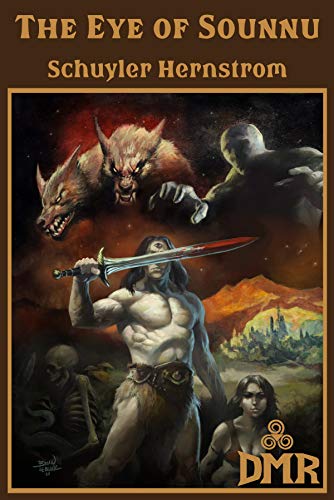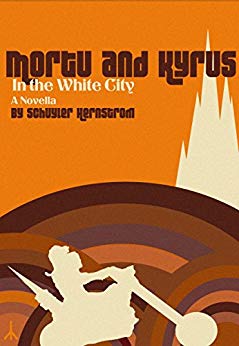 With the recent publishing of Mortu and Kyrus stories in The Eye of Sounnu and The Penultimate Men, let us revisit the first, “Mortu and Kyrus in the White City.”
With the recent publishing of Mortu and Kyrus stories in The Eye of Sounnu and The Penultimate Men, let us revisit the first, “Mortu and Kyrus in the White City.”
“Come then, try my steel and I will send you to hell where you belong. The gods of my people look down upon those that prey on the weak. There is no honor in it. There is no honor in you. I will enjoy killing you.”–Mortu
In Mortu and Kyrus in the White City, Schuyler Hernstrom returns to sword and sorcery, blending Dying Earth, Mad Max, and even a little Shaw Brothers kung fu into a future Earth recovering from the heavy hand of an alien overlord. The namesakes Mortu and Kyrus, a pagan motorcycle barbarian from the North and a Christian monk from Zantyum respectively, are on a quest to break the sorcerer’s spell that chains Kyrus into the form of a monkey. On the long road, they find a caravan attacked by nomads and a wayward Christian knight. Mortu and Kyrus intervene with a few sharp strokes of Mortu’s axe, and in gratitude, the caravan invites the duo to their White City. Within moments of their arrival, Mortu and Kyrus are swept up in the dark secrets beneath the foundations of the City.
Following in the well-worn path of sword-and-sorcery duos inspired by Fafhrd and the Gray Mouser, Mortu and Kyrus split the questing responsibilities in the traditional way. When presented with a mystery, Kyrus, as befitting a trickster or a thief, discovers why the mystery happens, while dour Mortu is called in to make sure the mystery ends. But Mortu is more in the mold of Conan than Fafhrd, a barbarian suspicious of civilization, not infatuated with it. Kyrus is a blend of Eastern and Western monk archtypes, a true believer, but a wandering monk nonetheless, full of the trickery and misfortune that such monks herald. Laudably, Hernstrom does not take the easy route and make Kyrus a hypocrite.
But then Hernstrom refuses the easy path throughout Mortu and Kyrus. None of the Christian characters are treated as hypocrites and monsters, a rarity in a genre that has long been hostile to Christianity (as E. Hoffman Price’s The Book of the Dead reveals). He treats the Cross as a civilizing force and a general good, although one Mortu still remains skeptical if it is an absolute good. While this is the first adventure available to readers, this is not an origin story. Mortu and Kyrus’s relationship is presented as established, and we are not forced to follow detailed stories of how Mortu and Kyrus met, how Kyrus got turned into a monkey, or of Mortu’s earlier life as a solo adventurer. At best, we see quick mentions, no more than needed in the course of brief conversation. The departure from current fashion is refreshing, and it hints at a greater world beyond the White City. Hernstrom deftly balances the mysteries of his wider world with the immediacy of sword and sorcery action. He accomplishes more worldbuilding with a few scraps of description than most writers accomplish with paragraphs of exposition. The effect is reminiscent of Vance’s The Last Castle, where entire swaths of human history are revealed in snatches of description and custom.
If Mortu and Kyrus seems a bit more predictable than Hernstrom’s previous works, it is because he has stepped up to the Great Conversation, “the ongoing process of writers and thinkers referencing, building on, and refining the work of their predecessors.” Here, readers can see the outlines of Ursula Le Guin’s “The Ones Who Walk Away From Omelas”, a particularly notable short work dealing with the dilemma of a hedonistic Eden fueled by the suffering of one innocent. The ones who cannot accept that their paradise requires the intentional suffering and neglect of a child walk away from the city, unwilling to benefit from his suffering, but unwilling to rescue the child. Omelas has been a popular parable in science fiction, revisited time and again, and by such notable shows as Doctor Who. At best, the protagonists rescue the child, but leave the society intact. Few, if any, render judgement against the people who benefited from the abuse of the child, nor prevent that society from finding a new child to torment for their pleasures. Mortu settles the Omelas dilemma with an older, more satisfying approach:
“You may talk of cities and justice all you wish. Tonight, the pagan wins. My anger will be sated and these wicked people brought to ruin.”
It is the approach of the hero, the pagan barbarian, and the Christian knight, illustrated in blood and adrenaline. One where actions matter more than intentions, and honor has meaning.
Fortunately, Mortu and Kyrus in the White City promises to be the first of many adventures for the barbarian biker and the monkey monk. Whether Hernstrom sets out to gore more sacred cows or just let Mortu gore more villains, I eagerly await the next.
 So that was back in 2018. What about now?
So that was back in 2018. What about now?
Time has not dulled my love for this series, nor my wait for more adventures. Mortu’s rage still provides eminently quotable lines that still run true. And others have spoken to better effect about Omelas and the moral aspects of Mortu and Kyrus.
Instead, let us turn to a different aspect of Hernstrom’s writing.
Alexandru Constantin has argued that much of today’s writing style is too thin to support the heft of many story’s themes, ideas, and action. Until recently, I had yet to see that. Until “The Battlefield of Kerres” by Jim Breyfogle. The earlier adventures of Mongoose and Meerkat are somewhat undermined by today’s contemporary classic style, although later stories are growing into something stylistic that matches the stories. Other authors have had the same problem, including a good many taught by the community around the Life, the Universe, and Everything writers’ convention. There are good lessons for craft from those circles, but the style taught there is plain, transparent, and so thin that the outline blocks and concepts can be seen like a skeleton beneath the prose.
Sky Hernstrom instead uses a deliberate style to give Mortu and Kyrus an otherworldly almost dreamlike tone that carries the moral dilemma and axe and sorcery forward to its conclusion. Mortu’s dialogue is quotable, not because it is clever or whimsical, as too many writers try for, because it is heroic, with care to the best phrasing possible. I will leave it to others more skilled in English to dissect the Hernstrom style, but read a long section of Mortu and Kyrus, The Gift of the Ob-Men, or The Law of the Wolves out loud. You will hear the difference and how a heroic style gives heroic deeds more impact.
I remain in awe of Hernstrom’s ability to imply entire civilizations worth of history in only a couple sentences. If there is one regret to the past couple years since Mortu and Kyrus was originally published, it is that the original cover is no longer used for the story. But the increased reach offered to Hernstrom by DMR Books is worth that sacrifice.
“Mortu’s dialogue is quotable, not because it is clever or whimsical, as too many writers try for, because it is heroic, with care to the best phrasing possible. …read a long section of Mortu and Kyrus, The Gift of the Ob-Men, or The Law of the Wolves out loud. You will hear the difference and how a heroic style gives heroic deeds more impact.”
Well put! That was something I noticed as well.
“I remain in awe of Hernstrom’s ability to imply entire civilizations worth of history in only a couple sentences.”
A talent he shares with Robert E. Howard, one of the very best practicioners of that particular skill to ever spin a yarn.